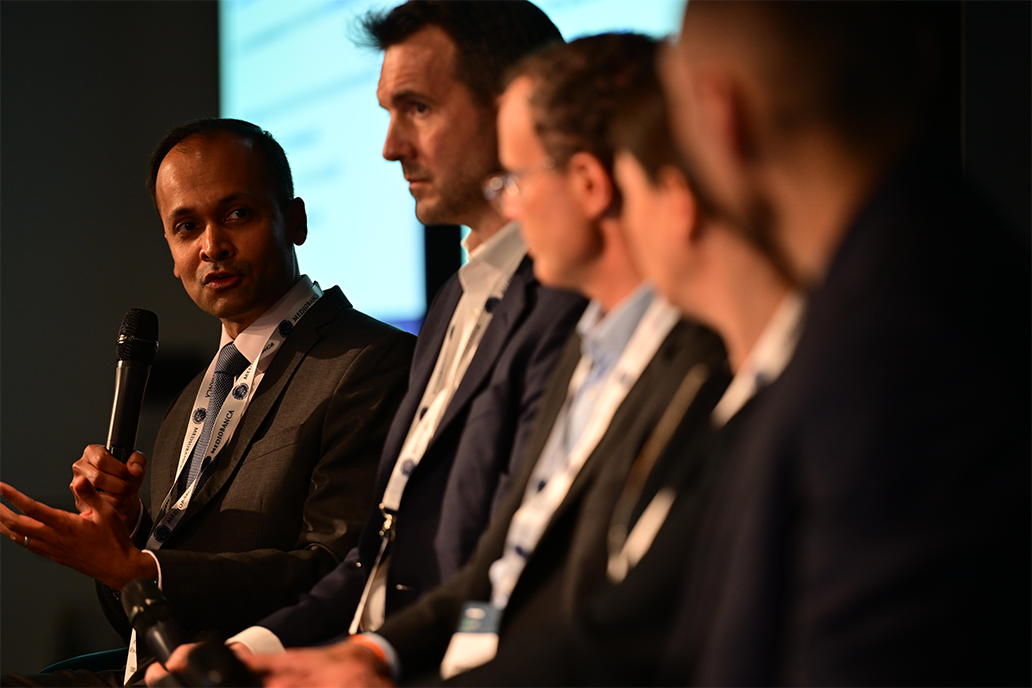Data and technologies could make it “more possible” for the industry to deliver better thematic indices, panelists said during the panel at SRP Europe Conference 2024 in London this week.
The market pivot from the conventional one-size-meets-all strategy has prompted index providers and banks to scratch their heads and agonise over how to use data to enhance the index-building process, panelists discussed on stage during the SRP Europe Conference 2024 on Tuesday (19 March) in London.
There is an appetite for new kinds of mechanisms for [AI-focused indices], but I think that we are very far from having the major AI crystal ball - Stéphane Mattatia, MSCI
Looking at the macro environment, the return of geopolitical events and global economic and business cycles in the past few years has intrigued a shift in investors’ appetite for structured products, considering those products tend to have long tenor, according to Stéphane Mattatia (below), managing director, global head of derivatives licensing and thematic indexes at MSCI.
“There will be rotation because of the business cycle,” Mattatia said. “We see appetite from clients who have smart indexes that would adapt themselves to the business cycle.”
Demand for thematic indices has always been high in the European market. Armelle Loeb-Darcagne, managing director and head of index sales Emea at STOXX, noted that there has been “some level of fragmentation” of index-linked structured products in Europe. The Swiss index provider debuted a digital asset-focused index and biodiversity index suite last year as the firm looks to build customisation for indices.
With the growing attention on artificial intelligence, data is crucial that the industry eyes to use to solve the design problem of a theme-focused index, noted Julien Thibaud (main picture), global head of derivatives at Morningstar Indexes.
“If you don’t have the proper data to tackle a theme, there won't be an index solution on the backend, [which would need to be considered] index construction and the term ‘thematic’ in a wider definition, which would include sectors and potentially ESG.”
Despite a decrease in the number of issuances for index-linked products in 2023, where ESG is primarily structured, the index-linked products’ notional was roughly the same as in 2022, according to Ari Rajendra (above, right), head of thematic indices at S&P Dow Jones Indices.
Rajendra sees that data and technologies can make it “more possible” for the industry to deliver better thematic indices. The benefit of using artificial intelligence is that it can capture themes more efficiently and categorise them based on significance.
Thibaud highlighted that product manufacturers are looking to find a “sweet spot” between the purity of the index and the complexity and limitations such as price and regulatory constraints.
When it comes to issuances of structured products with capital at risk dedicated to the retail market, there's complexity and limitations regarding numbers and mechanisms - Julien Thibaud, Morningstar
“I'll pick the French market as a good example: When it comes to issuances of structured products with capital at risk dedicated to the retail market, there's complexity and limitations regarding numbers and mechanisms,” Thibaud said. “Some of the advanced types of solutions cannot be deployed. Therefore, you’d need to stick to the pure sector approach.”
According to Thibaud, given some regional limitations, creating a static index may be a way out. “The static index isn’t involved in the ongoing selection process, and its composition is set from the start.
“It’s not new – the banks have been doing static indices forever. In Asia, it’s one of the privileged types of underlying when it comes to yield enhancement products that are usually in short maturities from six months to one year,” he said.
“From an index provider point of view, it’s simple to maintain since there is no selection. It’s straightforward and transparent,” Thibaud continued.
The challenges also came into the selection of the index and the weighting schemes, he said.
“None of the static solutions can be equally weighted, meaning we are attributing certain weight that you rebalance on a quarterly or monthly basis,” he said. “
“If one of the components decreases in value, you want to set the weights so that you can reinvest in this stuff against the other ones that were overperforming,” he said. “It feels like trying to catch a falling knife.”
“There is an appetite for new kinds of mechanisms for [AI-focused indices], but I think that we are very far from having the major AI crystal ball,” MSCI’s Mattatia concluded.



